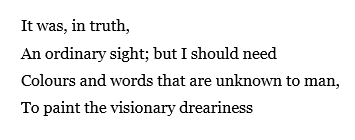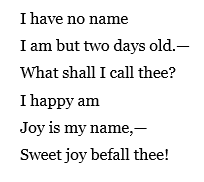57. The inexpressible, expressed
This post is also available in: Catalan
Nigel Fabb
University of Strathclyde, Glasgow
Language enables us to describe what we know of the world. But it is a common view, held in many cultures, that it is possible to have knowledge of something ‘beyond’ which cannot be described in ordinary language, but yet where it is possible to do things to language to express that knowledge. What is known is ineffable, and it may be a knowledge of some reality beyond ordinary reality, sometimes part of a religious or mystical experience. Here is Wordsworth’s expression of such a view, in The Prelude (1805, book 12):
I discuss now what in language enables us to express our knowledge of the world, but also what ordinarily escapes language, why special knowledge escapes language, and how language can be manipulated to express that special knowledge. Similar manipulations appear to be used across cultures.
Our knowledge of the world is largely tied up in schemata, the components of our memory where each schema is what we know of the types of things and events in the world, such as cats, tables, happiness, marriage, death, and so on. The vocabulary of a language names those schemata. We can put words together into sentences which make statements about the world. When we know something which is ineffable, this usually means that we know of something which is not expressed by a schema in our memory, since schemata can in principle be expressed in words. In this sense, ineffability is an extremely common situation, because almost everything we know about unique objects and events in the world is a knowledge of tokens, not of the generalized types. When I look at a leaf, I can name it in general terms as ‘leaf’ because it fits into the schema for leaf, but the specific leaf in itself is not schematic – it does not have a name of its own, separate from the name of the leaf next to it – and in this sense, the unique things in the world which we can have knowledge of are almost always ineffable. There are exceptions; for example, a unique person can have their own schema, and their own unique name, such as ‘Clarissa Dalloway’. Names, in this sense, can escape the limits of language to express unique real objects in themselves. Another way of getting directly at the unique things in the world is to use pronouns or other ‘pointing’ words (demonstratives), such as ‘there’ and ‘she’. These are ordinary ways of getting round the everyday ineffability of the unique aspects of reality. Literature can exploit these special devices as a way of expressing something beyond ordinary ineffable uniqueness, to get at the special moments in which the world is revealed; here the profound knowledge is expressed using tricks of language. An example comes in the moment of vision in the final paragraphs of Virginia Woolf’s Mrs. Dalloway (1925; this argument comes from Zhang 2014). In this moment, Peter sees an aspect of the world – here the reality of Clarissa Dalloway – in a profound way, and the text gets at this reality by using a name, a demonstrative and a pronoun.
The special status of names in many cultures can in part be understood in terms of their being windows into a reality which cannot normally be expressed in language. William Blake knew that there were dangers in opening up that window.
In this poem, which he engraved himself, using his own idiosyncratic punctuation system, Blake uses the only question mark in the whole of the collection from which it comes, Songs of Innocence (1789). And he uses it when the speaker tries to find a name for the child, which the child in a sense attempts to avoid by using a common noun ‘joy’ instead of the unique name by which it can be bound – a binding which the child undergoes in the parallel ‘Infant sorrow’ from the Songs of Experience (1794), a collection in which Blake engraved a great number of question marks. In many literatures and cultural practices, the problem of using words to refer to unique individuals is resolved another way, by using metaphors, descriptive phrases, or longer descriptions, which stand for the person. A characteristic practice is to use different descriptions in different parts of a poem, for the same person, sometimes in parallel sequences, such that the language appears to be circling around the reality of the person but rarely directly naming him or her. For example, in a Tswana praise poem discussed by Schapera (1965, cited Fabb 1997), the chief Bathoen I is referred to five times in a twelve-line sequence, but never directly – he is called leisantwa (after his age-set), rralesêgô (father of Lesego), segopê (elephant), lefenya (conquerer) and rramoswaana (the fair complexioned man). This may be a combination of two ways of using language to express the ineffable reality of a person: to use indirect descriptions, and to use multiple descriptions in parallel.
This brings us to another way of using language, particularly in poetry, to express meanings which are otherwise inexpressible, which is by the use of parallelism. Parallelism is a way of expressing the same meaning twice or more, using different words (Fabb 2017). This basically means that the meaning is not expressed directly at all, because the repetition suggests that neither of the individual expressions is enough to express what is actually meant, but rather that the meaning is to be found somewhere in the space between the parallel expressions. Forth (1988) says this about parallelism in the Rindi language (a variety of Eastern Sumbanese, Indonesia), where “it may not be the simpler reference of terms and phrases… in ritual language… which is screened off or disguised, so much as the precise sense in which terms are appropriate to their denotata”. Parallelism thus has something in common with metaphor, which is another device by which meanings which cannot be directly expressed can nevertheless be pointed to in language.
And now we come to metaphor itself, and the broader fact about language which metaphor exploits. This is that when we use language, what we communicate is not necessarily what the words and sentences literally mean. Instead, the literal meanings of the words and sentences are partial evidence of what we intend to communicate, and the words can be direct or indirect evidence. In metaphors, the words used are indirect evidence of the meaning which is communicated. This means that in ordinary communication, in principle we could communicate meanings which escape from the schematicity of language, because the language is just evidence for the meanings, not necessarily a direct expression of the meanings. In this regard, all kinds of ineffable meanings can be communicated using language as indirect evidence for the meaning. This is another way in which ineffability is always with us as a possibility even in ordinary language. In literature, and other cultural practices, metaphors can be central to the ways in which deeper realities can be expressed. Religious and mystical beliefs can often be expressed by making statements which would be untrue if the words were taken literally, such as ‘this statue can hear me speak’. Instead, we must take these words as indirect evidence of a deeper meaning, perhaps a meaning which cannot be itself put into words. A variant of the use of metaphor is the use of deliberate paradoxes and nonsense as a way of expressing deeper but otherwise inexpressible meanings. One example is found in the 15th century North Indian poet Kabir, who wrote some of his poems in ulatbamsi, ‘upside down language’, which “are absurd, paradoxical, crazy, impenetrable, and yet they purport to be meaningful” and have to be understood either by esoteric interpretation or by direct intuition (Hess 1983). Hess notes that “Kabir’s upside-down poems are part of a long tradition in India and can be related to similar expressions across the world.”
There are other ways of trying to get language to express normally inexpressible meanings, and this includes the invention of a new language. One of the driving forces here is the view that it is possible to have a language, different from our ordinary language, which can express a true reality. Thus Wilkins (1668) thought that Adam had a language in which he could directly understand God, which was subsequently destroyed after Babel: “And ’tis evident enough that the first Language was con-created with our first Parents, they immediately understanding the voice of God speaking to them in the Garden”. The desire to create a new language can be found across the twentieth century avant-garde, in all the media, where the new language might be able to provide access to a deeper reality. For example the composer Earle Brown (1986) seeks “a notational system that will produce an aural world which defies traditional notation and creates a performance ‘reality’ which has not existed before”. However it is not clear that any of these special approaches are necessary: the language we already have does not prevent us being able to know or communicate the ineffable. They depend on too narrow a view of words as constraining our access to reality.
The view that we have access to a knowable reality which we cannot express in language has an interestingly contradictory relation to another common view, which is that our language shapes how we think. This is the ‘Sapir-Whorf’ hypothesis; it is disputed within linguistics and psychology, but sometimes adopted uncritically in other disciplines as Fabb (2016) shows for economics, and it appeals to a common-sense view that our native language expresses our own reality. But the same general aspects of language which enable us to express ineffable meanings are some of the same aspects which mean that language cannot really constrain how we think.
In conclusion, we can see that ineffability is a common characteristic of the gap between what we can know and what we can say, and a characteristic which we would expect given that our vocabulary is finite but the range of what we can perceive and know is probably not finite. Furthermore, language does not determine what we can communicate, but is just one of the kinds of evidence for meaning which is involved in communication. Literature and other cultural practices exploit these characteristics of language, to express the inexpressible.
References
Brown, Earle 1986 The notation and performance of new music. Musical Quarterly 72 (2), 180-201.
Fabb, Nigel 1997. Linguistics and Literature: Language in the Verbal Arts of the World. Oxford: Blackwell [Trans. Fabb, N. 2006 Lingüística y Literatura. El lenguaje en las artes verbales del mundo. Madrid: A Machado Libros.]
Fabb, Nigel 2016. Linguistic theory, linguistic diversity and whorfian economics. In Victor Ginsburgh and Shlomo Weber (eds.) The Palgrave Handbook of Economics and Languages. London: Palgrave. pp.17-60.
Fabb, Nigel 2017. Poetic parallelism and working memory. Oral Tradition 31/2. Special issue on Parallelism in Verbal Art and Performance, ed. Frog & Lotte Tarkka.
Fabb, Nigel 2021. Experiences of Ineffable Significance In Elly Infantidou, Tim Wharton and Louis de Saussure (eds.) Beyond Meaning. Amsterdam: John Benjamins.
Forth, Gregory 1988. Fashioned Speech, Full Communication: Aspects of Eastern Sumbanese Ritual Language. In James J. Fox (ed.) To Speak in Pairs. Essays on the Ritual Languages of Eastern Indonesia. Cambridge: Cambridge University Press. pp. 129–160.
Hess, Linda 1983. The Cow Is Sucking at the Calf’s Teat: Kabir’s Upside-Down Language. History of Religions, 22 (4), pp.313-337
Schapera, I. 1965. Praise-poems of Tswana chiefs. Oxford: Oxford University Press.
Wilkins, John 1668. An essay towards a real character, and a philosophical language London: Printed for Sa. Gellibrand, and for John Martyn.
Zhang, Dora 2014. Naming the indescribable: Woolf, Russell, James and the limits of description. New Literary History, 45 (1), 51-70.



